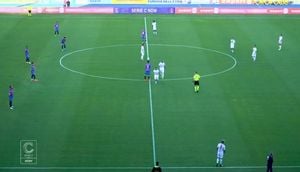With Germany's 2025 Federal Election looming just around the corner, voters are gearing up to make tough decisions about which parties to support. One tool making waves this election season is the Wahl-O-Mat, available online since February 6, 2025. The Wahl-O-Mat, introduced by the Federal Agency for Civic Education, encourages voters to engage with political party platforms and find matches based on their personal beliefs.
The Wahl-O-Mat presents users with 38 statements on various political issues. Participants can respond with "agree," "disagree," "neutral," or choose to skip statements they prefer not to answer. The process aims to shed light on the voter's political proximity to various parties by calculating match percentages based on their responses.
But there's more to the story than just the Wahl-O-Mat. Other tools have emerged to assist voters in their quest for political alignment. One such option is DeinWal, which allows users to reflect on past voting patterns by answering questions based on the German Bundestag's recent voting history. This resource reveals how closely users' votes aligned with each party's stances during previous legislative periods.
Another interesting alternative is the Real-O-Mat, which, much like DeinWal, focuses on real voting outcomes rather than party promises. This tool puts emphasis on how different parties voted on 20 significant issues, allowing voters to compare their opinions with those of the parties not just on theoretical grounds but based on actual legislative actions.
Stepping up from traditional interfaces, Wahl.Chat has introduced AI assistance for voters. Users can interact with this chat tool and ask questions about the parties’ positions on relevant themes, making the decision-making process more interactive. Unlike some other tools, though, Wahl.Chat primarily covers six parties likely to enter the Bundestag, which includes established political entities like CDU/CSU, SPD, Greens, and more.
The Wahl-Kompass, developed by researchers at the University of Münster, takes users through a question-and-answer framework very similar to the Wahl-O-Mat but allows for more nuanced responses on the political spectrum. It ranks parties based on users' responses and even considers users' demographics to provide more personalized results.
For those seeking speed and interactive matchmaking, there's VoteSwiper, which operates on the premise of swiping left or right, akin to popular dating apps. Users select positions on various topics, and at the end of the process, they receive their optimal match with parties based on their selections.
Some tools target specific issues. For example, the Agraromat is directed at agricultural policies relevant to farmers, and the WWF’s Zukunftswahl-Check reveals how parties view climate-related issues—ideal for environmentally-conscious voters.
Despite the availability of all these decision-making aids, many citizens still find themselves uncertain about who to support. According to recent surveys conducted by Forsa for Stern, 41% of Germans plan to use the Wahl-O-Mat, with 66% among 18 to 29-year-olds intending to engage with this tool as they navigate their choices.
Even with all these innovative tools and increased voter engagement efforts, the road to making final decisions on February 23 will still be challenging for many. Voter education initiatives continue to play key roles, as more citizens turn to these online platforms to clarify their political preferences and align themselves with the parties reaching out to their constituents.
The upcoming election is unprecedented, not just because of the myriad tools now available, but also because of the sheer number of parties contesting the elections—29 parties on the ballot, including prominent ones like SPD, CDU, Greens, and newer entrants aiming to establish themselves on the political stage.
With the Bundestagswahl rapidly approaching, the effectiveness of these tools will be tested as citizens weigh their options. Will the Wahl-O-Mat and its competitors provide the relief many voters hope for as they make choices about their political representatives for the next legislative term? Only time will tell, but for now, these platforms offer invaluable assistance as German voters prepare for the polls.



